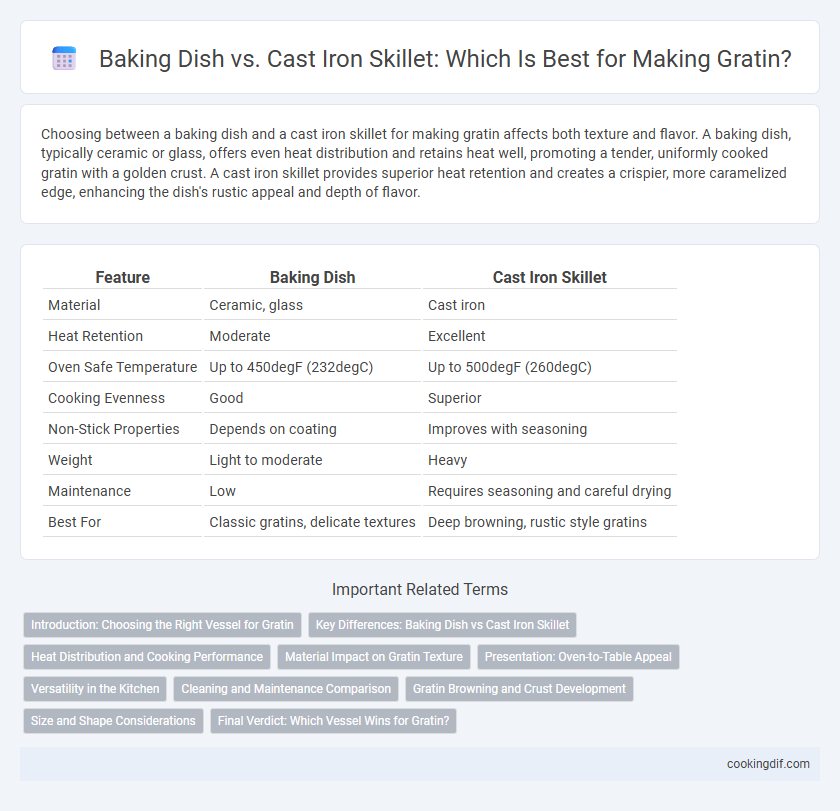Choosing between a baking dish and a cast iron skillet for making gratin affects both texture and flavor. A baking dish, typically ceramic or glass, offers even heat distribution and retains heat well, promoting a tender, uniformly cooked gratin with a golden crust. A cast iron skillet provides superior heat retention and creates a crispier, more caramelized edge, enhancing the dish's rustic appeal and depth of flavor.
Table of Comparison
| Feature | Baking Dish | Cast Iron Skillet |
|---|---|---|
| Material | Ceramic, glass | Cast iron |
| Heat Retention | Moderate | Excellent |
| Oven Safe Temperature | Up to 450degF (232degC) | Up to 500degF (260degC) |
| Cooking Evenness | Good | Superior |
| Non-Stick Properties | Depends on coating | Improves with seasoning |
| Weight | Light to moderate | Heavy |
| Maintenance | Low | Requires seasoning and careful drying |
| Best For | Classic gratins, delicate textures | Deep browning, rustic style gratins |
Introduction: Choosing the Right Vessel for Gratin
Selecting the ideal vessel for gratin significantly impacts cooking performance and texture. Baking dishes, often ceramic or glass, provide even heat distribution and a non-reactive surface that preserves the dish's flavors while allowing a golden crust to form. Cast iron skillets offer superior heat retention and develop a distinctive crispy edge, enhancing the gratin's flavor profile through their excellent heat conduction and seasoning.
Key Differences: Baking Dish vs Cast Iron Skillet
Baking dishes, typically made of ceramic or glass, offer even heat distribution and a non-reactive surface ideal for delicate gratins, preserving flavors without metallic interference. Cast iron skillets provide superior heat retention and develop a natural non-stick surface through seasoning, delivering a crispy, browned crust essential for gratin textures. The choice between ceramic or glass baking dishes and cast iron skillets hinges on desired cooking performance, heat conductivity, and textural outcome in gratin preparation.
Heat Distribution and Cooking Performance
A cast iron skillet offers superior heat retention and even heat distribution, essential for achieving a perfectly browned and crispy gratin crust. Baking dishes, often made from ceramic or glass, provide consistent heat but can have uneven cooking if not preheated properly, potentially leading to hot spots. The cast iron skillet's ability to withstand high oven temperatures and retain heat ensures optimal cooking performance and enhanced caramelization.
Material Impact on Gratin Texture
A baking dish made of ceramic or glass provides even heat distribution and gentle cooking, resulting in a creamy, uniformly browned gratin texture. Cast iron skillets retain and radiate heat intensely, creating a crispier, more caramelized crust while maintaining a tender interior. The material's heat conductivity directly influences the gratin's surface crispness and internal moisture balance, essential for achieving the desired texture.
Presentation: Oven-to-Table Appeal
A cast iron skillet offers superior oven-to-table appeal for gratin presentation due to its rustic, yet elegant appearance and excellent heat retention, keeping the dish warm longer. Baking dishes, typically made of ceramic or glass, provide a cleaner, more polished look but may cool faster once out of the oven. Choosing a cast iron skillet enhances both the visual impact and the dining experience, making it ideal for serving gratin directly from oven to table.
Versatility in the Kitchen
A cast iron skillet offers superior versatility in the kitchen by transitioning seamlessly from stovetop to oven, making it ideal for dishes that require searing before baking. Baking dishes, typically made of ceramic or glass, excel at even heat distribution for consistent browning but lack stovetop compatibility. Choosing a cast iron skillet enhances multitasking capabilities and heat retention, which benefits a wide range of recipes beyond gratins.
Cleaning and Maintenance Comparison
Cast iron skillets require seasoning and careful drying to prevent rust, making maintenance more labor-intensive compared to baking dishes, which are typically dishwasher safe and easier to clean. Baking dishes, often made of ceramic or glass, resist staining and odors, reducing ongoing upkeep. Cast iron's durability withstands high heat and heavy use but demands regular conditioning, unlike the more hassle-free care of common baking dishes.
Gratin Browning and Crust Development
A cast iron skillet provides superior heat retention and even distribution, promoting a deeply browned, crispy crust essential for an ideal gratin. Baking dishes, often made from ceramic or glass, heat more slowly, resulting in a gentler browning process that delivers a tender, less crunchy crust. Selecting cast iron enhances Maillard reaction intensity, creating rich color and robust texture, while baking dishes offer a milder crust with consistent heat exposure.
Size and Shape Considerations
Selecting the right vessel for a gratin depends heavily on size and shape considerations; baking dishes often come in rectangular or oval shapes ideal for evenly layered ingredients and larger portions, while cast iron skillets offer a round shape that enhances heat retention for crispier edges in smaller servings. Baking dishes typically range from 1.5 to 3 quarts, perfect for family-sized gratins, whereas cast iron skillets vary from 8 to 12 inches in diameter, suitable for personal or side-dish portions. Choosing between the two depends on whether precise layering and presentation or rustic texture and heat distribution are prioritized for the gratin.
Final Verdict: Which Vessel Wins for Gratin?
A cast iron skillet excels in heat retention and even cooking, resulting in a perfectly browned, crispy gratin crust with tender insides. Baking dishes, typically ceramic or glass, offer more uniform heat distribution and an elegant presentation but may lack the intense searing capability of cast iron. For optimal gratin results, cast iron skillets are preferred for their superior caramelization and rustic texture, while baking dishes suit traditional, gentle cooking and serving.
Baking dish vs Cast iron skillet for vessel Infographic

 cookingdif.com
cookingdif.com